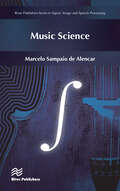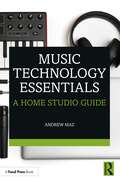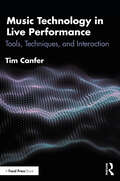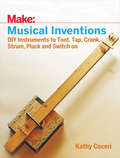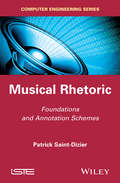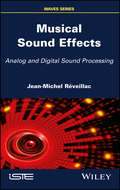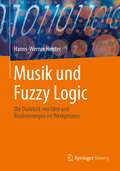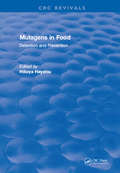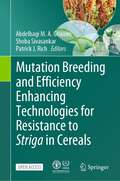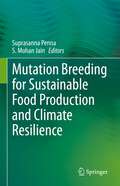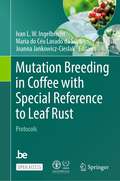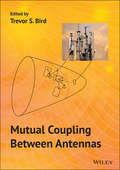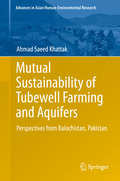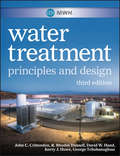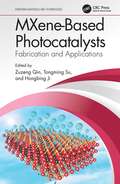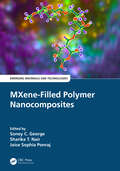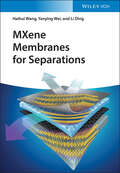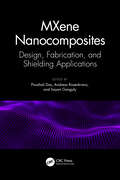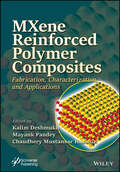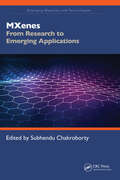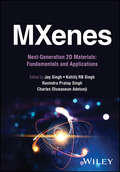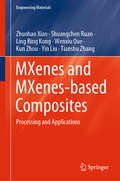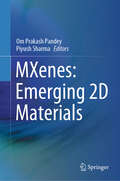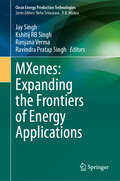- Table View
- List View
Music Science (River Publishers Series In Signal, Image And Speech Processing Ser.)
by Marcelo Sampaio AlencarThe book presents the fundamentals of music science, followed by a discussion on the historical evolution of music. An introduction to the analysis of signals in time and frequency is presented, which includes sound and noise. Features and mathematical aspects of the sound are discussed, including vibration and timbre.The book presents a review of existing voice models and discusses the voice production, sound perception, music characteristics and acoustics, tempo, rhythm and harmony. Musical theory is presented, including staff, notes, alterations, keys and intervals, tones and associated frequencies and wavelengths. The creation of major and minor scales is emphasized, along with a study on consonance and dissonance, measure, metric, tempo markings, dynamics, modulation. The book also explains the chord formation, and discusses melody and composition.The book has four appendices, including an appendix on the basic differentiation and integration theorems, another with useful Fourier tables, and an appendix featuring the notes, their frequencies and wavelengths. The book also has a glossary of music terms.
Music Technology Essentials: A Home Studio Guide
by Andrew MazMusic Technology Essentials provides an overview of the vocabulary, techniques, concepts, and devices used in contemporary music production and guides readers through the essential fundamentals of music technology so that they can create their own music productions at home. This highly accessible book covers sound fundamentals and theory, as well as practical topics like hardware, software, MIDI, digital audio, synthesis, computer notation, and audio-visual applications, to equip the reader with the principles they need to achieve professional-sounding results. Each chapter is accompanied by real-life examples and exercises that can be applied to any digital audio workstation software, to put the lessons into practice. This book will also help readers evaluate their requirements for home music production while working within a sensible budget. Music Technology Essentials is the ideal textbook for beginners inside and outside of the classroom, including those on music and music production courses, who wish to enter the world of music technology but are unsure where to start or what to purchase.
Music Technology in Live Performance: Tools, Techniques, and Interaction
by Tim CanferMusic Technology in Live Performance explores techniques to augment live musical performance and represents a comprehensive guide to best practices in music technology for live performance. This book presents a practical and accessible introduction to the theories of liveness and an array of live performance technologies and techniques. Areas covered include analogue and digital audio, live sound, the recording studio, and electronic music, revealing best professional practices and expert tips, alongside an exploration of approaches to increasing the exchange of energy in live performance. Music Technology in Live Performance is an ideal introduction for students of music performance, music production, and music technology, and a vital resource for professional musicians, producers, and technology developers.
The Musical Art of Synthesis
by Sam McGuire Nathan Van der RestNew synths with unique features and layers of complexity are released frequently, with hundreds of different synths currently available in the marketplace. How do you know which ones to use and how do you get the most out of the ones you already own? The Musical Art of Synthesis presents synthesizer programming with a specific focus on synthesis as a musical tool. Through its innovative design, this title offers an applied approach by providing a breakdown of synthesis methods by type, the inclusion of step-by-step patch recipes, and extensive web-based media content including tutorials, demonstrations, and additional background information. Sam McGuire and Nathan van der Rest guide you to master synthesis and transcend the technical aspects as a musician and artist. Synths are presented using a multi-tiered system beginning with basic instructions for all common synth techniques. Historical information is included for each type of synth, which is designed to help you understand how each instrument relates to the bigger picture. Advanced level instruction focuses on modern implementations and on mobile devices, with special focus on performing and practical usage. The goal The Musical Art of Synthesis is to bring all of the different types of together in the same discussion and encourage you to see the similarities and differences that force you to gain a better overall understanding of the synthesis process. Key features of this title: • This book will teach you how to put synthesizers to use with easy-to-use synth patch recipes • Using a unique, multi-tiered approach applicable to the level of equipment in use, this publication introduces concepts that apply to a wide range of hardware/software synthesizers. • A robust companion website, featuring video demonstrations by synthesizer experts, further supports the book: www.focalpress.com/cw/mcguire
Musical Inventions: DIY Instruments to Toot, Tap, Crank, Strum, Pluck, and Switch On
by Kathy CeceriPeople have been playing music on homemade instruments for thousands of years. But creating new instruments is much more than an art form. When you want to make a note sound higher or lower, you have to change the sound waves coming out of the instrument. That's science! When you explore the way different materials produce different sounds, that's engineering. When you speed up or slow down a song, you're counting beats -- using math. And technology makes electronic instruments and devices to record and play back music possible.
Musical Rhetoric: Foundations and Annotation Schemes
by Patrick Saint-DizierDiscourse analysis and rhetoric are very much developed in communication, linguistics, cognitive science and artificial intelligence. Besides theoretical investigations, discourse analysis is central in a number of application areas such as dialogue and negotiation, the semantic web, question answering or authoring systems. Music is also a natural language, more abstract and mathematical, which follows very strict construction principles. However, there is very limited and no recent literature on Music Discourse analysis using computational principles. This book aims at developing a central issue in musical discourse: modeling rhetoric and argumentation. It also contributes to the development of high-level multimedia annotation schemes for non-verbal communication.
Musical Sound Effects: Analog and Digital Sound Processing
by Jean-Michel RéveillacFor decades performers, instrumentalists, composers, technicians and sound engineers continue to manipulate sound material. They are trying with more or less success to create, to innovate, improve, enhance, restore or modify the musical message. The sound of distorted guitar of Jimi Hendrix, Pierre Henry’s concrete music, Pink Flyod’s rock psychedelic, Kraftwerk ‘s electronic music, Daft Punk and rap T-Pain, have let emerge many effects: reverb, compression, distortion, auto-tune, filter, chorus, phasing, etc. The aim of this book is to introduce and explain these effects and sound treatments by addressing their theoretical and practical aspects.
Musik und Fuzzy Logic: Die Dialektik von Idee und Realisierungen im Werkprozess
by Hanns-Werner HeisterDas Buch entfaltet die vielfältigen Wechselbeziehungen zwischen Fuzzy Logic und Musik in einem ersten umfassenden Überblick. Es behandelt systematisch sowohl die in diesem Zusammenhang relevanten Aspekte der Fuzzy Logic als auch die der Musik. Im Werkprozess mit drei Hauptphasen und dreizehn Existenzformen des Kunstwerks, in den Musikarten Klassik, Jazz, Pop, Folklore, zeigen sich die vier Hauptprinzipien (mit fünf Phänotypen) der Fuzzy Logic in Bezug auf die Musik: Ähnlichkeit, Schärfung I als Filterung und Schärfung II als Kristallisation, Verwischung, Variation. Ein neues Konzept ist die Dialektik zwischen Schärfung und – bewusster – "Unschärfe" durch die Verwischung. Abschließend werden Aspekte der mehrdimensionalen Dialektik in historischer Dimension entwickelt, samt einem ‚Musical Turn‘ in den Wissenschaften und Überlegungen zu einer 'Philosophie der FL'. Das produktionsorientierte Denken der Fuzzy Logic und die Musik-Analyse befruchten sich wechselseitig.
Mutagens in Food: Detection And Prevention
by Veikko HayatsuThis book describes many different kinds of mutagens that are detected in food, and also discusses various ways to suppress their formation and activities. The mutagens discussed include those of natural origin, those caused by human manipulation of food (e.g., cooking and adding preservatives), and those formed after food has been consumed (e.g., nitrosamines). Other topics include mutagenesis and mutagen-formation inhibitors, contemporary mutagen detection methods, the fate of ingested mutagens, and risk assessments for mutagens as human carcinogens. The book emphasizes cooked-food mutagens, especially the heterocyclic amines, because of their potential as human carcinogens. Researchers and students concerned with mutagens in food will consider this book to be valuable additions to their reference libraries.
Mutation Breeding and Efficiency Enhancing Technologies for Resistance to Striga in Cereals
by Abdelbagi M. A. Ghanim Shoba Sivasankar Patrick J. RichThis open access book is a compilation of protocols developed through a Coordinated Research Project of the Joint FAO/IAEA Center of Nuclear Techniques in Food and Agriculture, specifically focused on mutation breeding for resistance to Striga. The book consists of three sections; (i) a general introduction on Striga biology and impact and mutagenesis in cereal crops; (ii) protocol chapters focusing on field, screenhouse and laboratory screening and diagnostic for resistance to Striga asiatica and S. hermonthica in sorghum, upland rice and maize, and; (iii) efficiency enhancing technologies such as rapid crop cycling, doubled haploid production and genomics for mutation discovery and marker development. These chapters were written by well recognized experts in Striga biology and physiology, and cereal breeders. The book is intended to serve as a unique reference and guide for plant breeders and geneticists engaged in breeding for resistance to Striga in cereals.
Mutation Breeding for Sustainable Food Production and Climate Resilience
by Suprasanna Penna S. Mohan JainThis book highlights the recent progress on the applications of mutation breeding technology in crop plants. Plant breeders and agriculturists are faced with the new challenges of climate change, human population growth, and dwindling arable land and water resources which threaten to sustain food production worldwide. Genetic variation is the basis which plant breeders require to produce new and improved cultivars. The understanding of mutation induction and exploring its applications has paved the way for enhancing genetic variability for various plant and agronomic characters, and led to advances in gene discovery for various traits. Induced mutagenesis has played a significant role in crop improvement and currently, the technology has resulted in the development and release of more than 3600 mutant varieties in most of the crop plants with great economic impact. The field of ‘mutation breeding’ has come long way to become an important approach for crop improvement. This book covers various methodologies of mutation induction, screening of mutants, genome editing and genomics advances and mutant gene discovery. The book further discusses success stories in different countries and applications of mutation breeding in food crops, horticultural plants and plantation crops.This informative book is very useful to plant breeders, students and researchers in the field of agriculture, plant sciences, food science and genetics.
Mutation Breeding in Coffee with Special Reference to Leaf Rust: Protocols
by Ivan L. W. Ingelbrecht Maria do Céu Lavado da Silva Joanna Jankowicz-CieslakThis open-access book provides a comprehensive overview of current methodologies for improving resistance to leaf rust in coffee, one of the world's most important cash crops and beverages. Coffea arabica L. (Arabica) accounts for about 60% of the world's coffee production. Coffee leaf rust (CLR), caused by the fungus Hemileia vastatrix is the major disease affecting Arabica coffee resulting in losses of over $1 billion annually. The geographical distribution of CLR is expanding due to climate change. Moreover, the genetic improvement of Arabica coffee is constrained due to its very narrow genetic base. This protocol book introduces essential concepts of mutation breeding as an efficient tool to increase the genetic diversity of Arabica coffee and presents practical methods on mutation induction and screening for resistance to CLR. Current breeding approaches, challenges and opportunities for Arabica coffee improvement are briefly reviewed and a survey of common coffee diseases with emphasis on CLR is presented. Practical protocols for mutation induction and screening for resistance to CLR are described, including novel methods for single-cell mutagenesis using in vitro cell and tissue culture techniques and for genome-wide screening of induced mutations using genomics tools. Each protocol chapter has an introduction and is supported by example results. Given the impact of recent CLR epidemics on Arabica coffee production in Latin America, the book is intended to serve as a timely reference and guide for students and researchers in the agricultural sciences, plant pathologists and breeders, as well as growers and end-users interested in producing novel coffee genotypes for genetic studies, breeding, and commercial applications.
Mutual Coupling Between Antennas
by Trevor S BirdMutual Coupling Between Antennas A guide to mutual coupling between various types of antennas in arrays such as wires, apertures and microstrip patches or antennas co-sited on platformsMutual Coupling Between Antennas explores the theoretical underpinnings of mutual coupling, offers an up-to-date description of the physical effects of mutual coupling for a variety of antennas, and contains techniques for analysing and assessing its effects. The book puts the topic in historical context, presents an integral equation approach, includes the current techniques, measurement methods, and discusses the most recent advances in the field.With contributions from noted experts on the topic, the book reviews practical aspects of mutual coupling and examines applications that clearly demonstrate where the performance is impacted both positively and negatively. Mutual Coupling Between Antennas contains information on how mutual coupling can be analysed with a wide range of methods from direct computer software using discrete methods, to integral equations and Greens function methods as well as approximate asymptotic methods. This important text:Provides a theoretical background for understanding mutual coupling between various types of antennasDescribes the interaction that occurs between antennas, both planned and unplannedExplores a key aspect of arrays in any wireless, radar or sensing system operating at radio frequenciesOffers a groundbreaking book on antenna mutual couplingWritten for antenna engineers, technical specialists, researchers and students, Mutual Coupling Between Antennas is the first book to examine mutual coupling between various types of antennas including wires, horns, microstrip patches, MIMO antennas, co-sited antennas and arrays in planar or conformal configurations.
Mutual Sustainability of Tubewell Farming and Aquifers
by Ahmad Saeed KhattakThis book develops and presents a conceptual model for sustainable-groundwater irrigated agriculture. The model is based on the general principles of the economic theories of cost-benefit relations and behavioral models of resource use. The study has evaluated the advances in tubewell farming and the aquifer potential in arid Balochistan over a period of three decades. It has analyzed the booms and busts of the farming over time taking into consideration the local aquifer limitations and the socio-political considerations and policy framework. Three data sets - farmers, expert officials and satellite images - have been used to aid validation. By observing the most vital parameters, the study has concluded that the local aquifer has been falling at a rate directly proportional to the growth rate of irrigated farming, suggesting the current development process is unsustainable. For instance, the research finds that tubewell bores have reached down to depths where the term "aquifer mining" applies; as a result, irrigation costs have become too high to allow farming to be economically viable. In addition, desertification is steadily encroaching and the cropping pattern being changed from high-value horticulture to subsistence cropping. The study has also set parameters for assessing the willingness of farmers to accept modern, sustainable strategies and interventions.
MWH's Water Treatment
by Kerry Howe John C. Crittenden David W. Hand R. Rhodes Trussell George Tchobanoglousthe definitive guide to the theory and practice of water treatment engineering This newly revised edition of the classic reference provides complete, up-to-date coverage of both theory and practice of water treatment system design. The Third Edition brings the field up to date, addressing new regulatory requirements, ongoing environmental concerns, and the emergence of pharmacological agents and other new chemical constituents in water. Written by some of the foremost experts in the field of public water supply, Water Treatment, Third Edition maintains the book's broad scope and reach, while reorganizing the material for even greater clarity and readability. Topics span from the fundamentals of water chemistry and microbiology to the latest methods for detecting constituents in water, leading-edge technologies for implementing water treatment processes, and the increasingly important topic of managing residuals from water treatment plants. Along with hundreds of illustrations, photographs, and extensive tables listing chemical properties and design data, this volume: Introduces a number of new topics such as advanced oxidation and enhanced coagulation Discusses treatment strategies for removing pharmaceuticals and personal care products Examines advanced treatment technologies such as membrane filtration, reverse osmosis, and ozone addition Details reverse osmosis applications for brackish groundwater, wastewater, and other water sources Provides new case studies demonstrating the synthesis of full-scale treatment trains A must-have resource for engineers designing or operating water treatment plants, Water Treatment, Third Edition is also useful for students of civil, environmental, and water resources engineering. MWH is a global consulting firm with more than 7,000 professionals and 180 offices in thirty-five countries, that provides services to a full range of water-related projects and programs ranging from water supply, treatment and storage, dams, water management for the natural resources industry, and coastal restoration to renewable power and environmental service. MWH employees wrote the first edition of this book.
MXene-Based Photocatalysts: Fabrication and Applications (Emerging Materials and Technologies)
by Zuzeng QinMXene, a two-dimensional (2D) transition metal carbide, nitride, and carbonitride, was discovered in 2011. MXene has great potential as a cocatalyst in the field of photocatalysis due to its unique properties and structure. MXene-Based Photocatalysts: Fabrication and Applications introduces readers to the fundamentals, preparation, microstructure characterization, and a variety of applications of MXene-based photocatalysts. The book is a comprehensive reference for MXene materials and provides an overview of the current literature on MXene-based photocatalysts. FEATURES Discusses preparation methods of MXenes Describes the morphology and microstructure of MXenes Offers strategies for fabricating MXene-based photocatalysts Details the reaction mechanism of MXene-based photocatalysts Covers applications in photocatalytic water-splitting, photocatalytic CO2 reduction, photocatalytic degradation, photocatalytic nitrogen fixation, and photocatalytic H2O2 production This book serves as an invaluable guide for advanced students, industry professionals, professors, and researchers in the field of materials science and engineering, photocatalysis, energy, and environmental applications.
MXene-Filled Polymer Nanocomposites (Emerging Materials and Technologies)
by Soney C. George Sharika T. Nair Joice Sophia PonrajMXenes are a new family of two-dimensional (2D) metal carbides, having properties such as metallic conductivity and hydrophilicity. Adding polymer binders/spacers between atomically thin MXene layers or reinforcing polymers with MXenes results in composite films that have excellent flexibility, good tensile and compressive strengths, and electrical conductivity. This book covers all advances in the field of MXene-filled polymer nanocomposites to date, illustrating fabrication and characterization, and specific properties like anti-healing, anti-friction, and microwave absorption. It further covers potential applications like energy conversion, storage systems, antibacterial, and drug delivery. The book features: exclusive material on MXene-based polymer nanocomposites; properties and potential applications of polymers upon addition of MXenes; the effect of MXenes on various thermoplastic and elastomer polymers; a focus on the properties, fabrications methods, and applications of relevant polymer matrices; and extensive coverage of the role of MXenes in polymers. This book is aimed at researchers, professionals, and graduate students in material science, polymer engineering, electronic materials, composites, chemical processing, chemical sciences, fire engineering, and biomedicine.
MXene Membranes for Separations
by Haihui Wang Yanying Wei Li DingExplore critical and groundbreaking MXene applications and technologies In MXene Membranes for Separations, a team of distinguished researchers delivers a comprehensive and instructive summary of the latest research and techniques in the development of MXene. It offers an insightful view of MXene properties as a membrane in separation applications, including gas separation, ion sieving, solvent dehydration, nanofiltration, and ultrafiltration. Covering various aspects of two-dimensional membranes based on MXene materials, the book summarizes the separation mechanism, compares separation performances, and analyzes the advantages and disadvantages of different approaches. It also considers the research and industrial prospects of current MXene membranes for separation applications on nanofiltration, gas separation, ion sieving, solvent dehydration, and water/oil separation. The book also includes: A thorough introduction to 2D membranes, including membrane development, separation mechanisms, and fabrication methods Comprehensive explorations of MXene nanosheets and membranes, including the preparation and characterization of MXene nanosheets and membranes Practical discussions of MXene membranes for the isolation of antibiotics, including explorations of physical adsorption and advanced oxidation In-depth examinations of MXene membranes for ion separation Perfect for membrane scientists, materials scientists, and inorganic chemists, MXene Membranes for Separations will also earn a place in the libraries of complex chemists and engineering scientists seeking a timely overview of critical MXene applications.
MXene Nanocomposites: Design, Fabrication, and Shielding Applications
by Poushali Das Andreas Rosenkranz Sayan GangulyMXenes offer single step processing, excellent electrical conductivity, easy heat dissipation behavior, and capacitor-like properties and are used in photodetectors, lithium-ion batteries, solar cells, photocatalysis, electrochemiluminescence sensors, and supercapacitors. Because of their superior electrical and thermal conductivities, these composites are an ideal choice in electromagnetic interference (EMI) shielding. MXene Nanocomposites: Design, Fabrication, and Shielding Applications presents a comprehensive overview of these emerging materials, including their underlying chemistry, fabrication strategies, and cutting-edge applications in EMI shielding. • Covers modern fabrication technologies, processing, properties, nanostructure formation, and mechanisms of reinforcement. • Discuss biocompatibility, suitability, and toxic effects. • Details innovations, applications, opportunities, and future directions in EMI shielding applications. This book is aimed at researchers and advanced students in materials science and engineering and is unique in its detailed coverage of MXene-based polymer composites for EMI shielding.
MXene Reinforced Polymer Composites: Fabrication, Characterization and Applications
by Kalim Deshmukh Mayank Pandey Chaudhery Mustansar HussainMXene Reinforced Polymer Composites This volume is the first book to comprehensively explore the various fabrication and processing strategies for MXene-reinforced polymer composites including detailed characterizations and their numerous applications. The book systematically provides a critical discussion on the synthesis and processing methods, structure, properties, characterizations, surface chemistry, and functionalization strategies of MXenes and their utilization as efficient nanofiller into various polymer matrices to form high-performance polymer composites. The book provides a deep insight into the recent state-of-the-art progress in MXene-reinforced polymer composites, discussing several critical issues and providing suggestions for future work. The key features of this book are: Providing fundamental information and a clear understanding of the synthesis, processing, compositions, structure, and physicochemical properties of MXenes; Presenting a comprehensive review of several recent accomplishments and key scientific and technological challenges in developing MXene-reinforced polymer composites; Exploring various processing and fabrication methods of MXene-reinforced polymer composites; Providing deep insight into fundamental properties and various emerging applications of MXene-reinforced polymer/composites. Audience Researchers, postgraduates, and industry engineers working in materials science, polymer science, materials engineering, and nanotechnology, as well as technologists in electronic, electrical, and biomedical industries.
MXenes: From Research to Emerging Applications (Emerging Materials and Technologies)
by Subhendu ChakrobortyThis book introduces MXenes and provides a summary of current discoveries in their synthesis, properties, characterization techniques, and emerging applications in several fields. It explores MXenes' distinctive electrical, mechanical, and biological features, as well as their applications. It discusses the various emerging applications of MXenes in a variety of fields, including regenerative medicine and tissue engineering, separation membranes, photocatalytic hydrogen production, environmental applications, and so forth.Features: Provides comprehensive review of synthesis and application of MXenes in 2D materials Explores greener approaches that reduce the environmental impact and cost of the process Includes frameworks for assessing the balance between the synthesis and applications Discusses an overview of MXenes with a focus on energy, health, and medical applications that can be improved with new encapsulation Reviews the modern spectroscopic instruments that are utilized in sophisticated characterization methods This book is aimed at researchers and graduate students in materials engineering, nanomaterials, and 2D materials.
MXenes: Fundamentals and Applications
by Jay Singh Kshitij Rb Singh Ravindra Pratap Singh Charles Oluwaseun AdetunjiMXenes One-stop reference explaining the manufacturing, design, and many applications of MXenes in an easy-to-understand linear format MXenes is a one-stop reference on MXenes, a promising new class of 2D materials, discussing the routes of functionalization and modifications towards high performance materials and providing broad coverage of lab synthesis methods. To aid in reader comprehension, this text presents the topic in a linear fashion, starting with an introduction to MXenes and ending with a comparison of MXenes to other similar 2D materials, discussing limitations, advantages, future perspectives, and challenges of both MXenes and MXene-based materials. The text covers up-to-date research in the field with a strong focus on novel findings in various devices along with core technological advancements that have been made in recent years. MXenes discusses sample topics such as: Properties of MXenes, including strong hydrophilicity, exceptional conductivity, high elastic mechanical strength, large surface-to-volume ratio, and chemical stability Applications of MXenes in energy storage, optoelectronics, spintronics, biomedicine, electro-catalysis, photocatalysis, membrane separation, supercapacitors, and batteries Performance factors that can hinder the efficacy of MXenes, including aggregation, difficulty obtaining a single layer, restacking, and oxidation of MXene nanosheets State-of-the-art progress in the field of gas sensors and electrochemical biosensors for the detection of various biomolecules, pharmaceutical drugs, and environmental pollutants Containing everything readers need to know about this exciting new class of 2D materials, MXenes is an essential reference for professionals working in advanced materials science, flexible electronics, nanoelectronics, and the energy industry, along with chemists, material scientists, and engineers in nanoscience and nanotechnology.
MXenes and MXenes-based Composites: Processing and Applications (Engineering Materials)
by Zhuohao Xiao Shuangchen Ruan Ling Bing Kong Wenxiu Que Kun Zhou Yin Liu Tianshu ZhangIn this book, the authors cover the recent progress in the synthesis, characterization and application of various multi-layered carbides, carbonitrides and nitrides. Moreover, the processing and development of MXene-based composites are elaborated, focusing on their applications and performances as transparent conductors in environmental remediation and energy storage systems.
MXenes: Emerging 2D Materials
by Piyush Sharma Om Prakash PandeyThis book focuses on the expanding market for 2D MXenes and their increasing importance in future applications. It provides a thorough understanding of MXenes and their derivatives by exploring their complex composition and chemical diversity. The book provides a thorough examination of synthesis processes, characterization methodologies, and crucial attributes, which may give significant insights for both researchers and engineers. Furthermore, the book explores diverse applications of MXenes, spanning from energy storage and catalysis to electronics and beyond, thus highlighting their vast potential in driving technological innovation. Additionally, by elucidating the current state and challenges hindering the commercialization of 2D MXenes, this resource serves as a valuable guide for navigating the path towards widespread adoption. This book is an essential resource for scientists, engineers, research researchers, and students who want to delve into the captivating realm of 2D MXenes. Its interdisciplinary approach makes it a valuable tool.
MXenes: Expanding the Frontiers of Energy Applications (Clean Energy Production Technologies)
by Jay Singh Kshitij Rb Singh Ranjana Verma Ravindra Pratap SinghThe book covers fundamental aspects, explores the synthesis, composition, and various properties of this next-generation 2D material, and provides an account of the processing and development of MXenes and MXene-based composites. This book stands out as a unique contribution, focusing on two major aspects: fundamentals and energy storage applications. It thoroughly examines notable findings and technological challenges in detail. The aim is to bridge the knowledge gap in materials science, nanotechnology, and energy storage devices. The book discusses recent developments in MXenes and MXene-based composites for energy storage, including applications in supercapacitors, hybrid-ion capacitors, batteries, point-of-care devices, hydrogen storage, nanoelectronics, catalysis, electro/photocatalysis, and biofuel devices. This book provides a complete set of knowledge about 2D materials, specifically MXenes. The book serves as an excellent reference for researchers, scientists, and engineers. Moreover, it serves as a useful guide for undergraduate, postgraduate, and Ph.D. students, as well as academicians, scientists, researchers, and industry specialists working in advanced materials science, flexible electronics, nanoelectronics, and energy storage devices.
